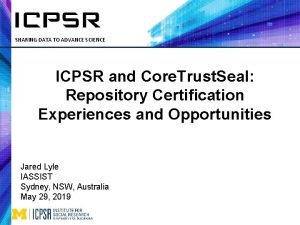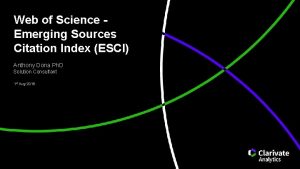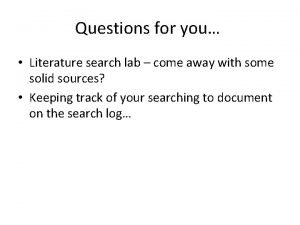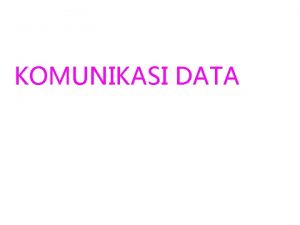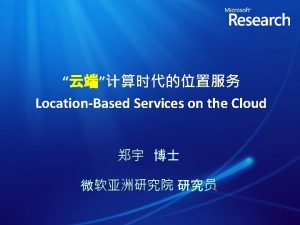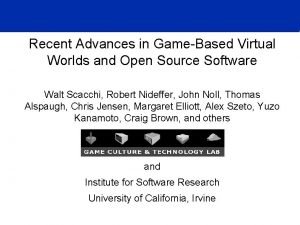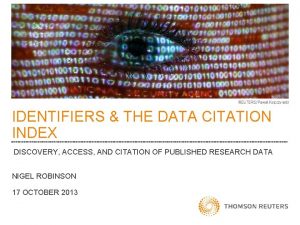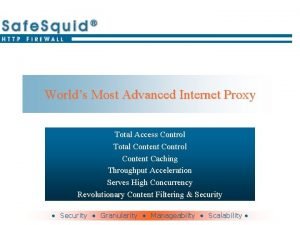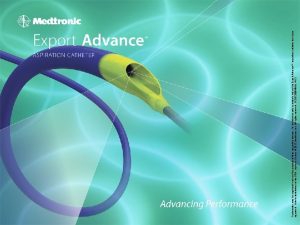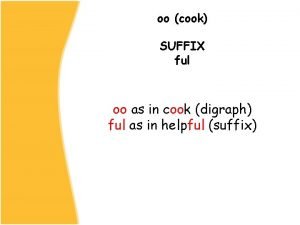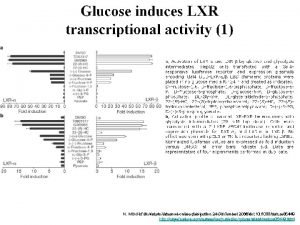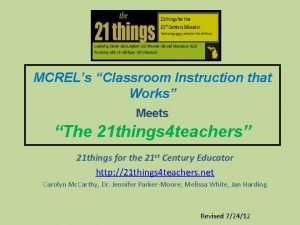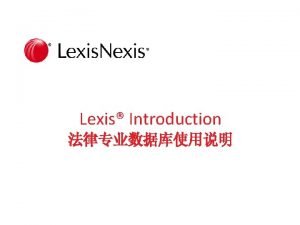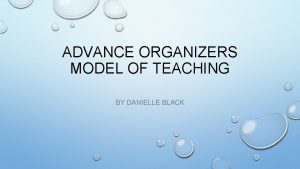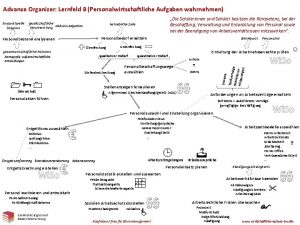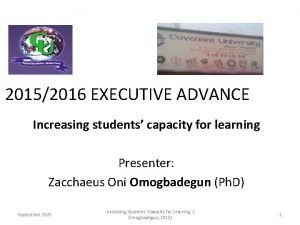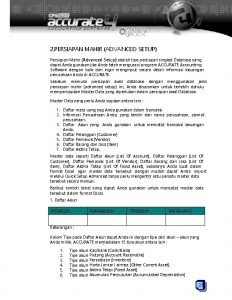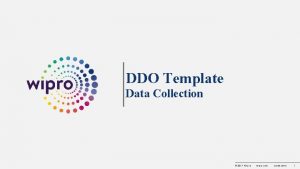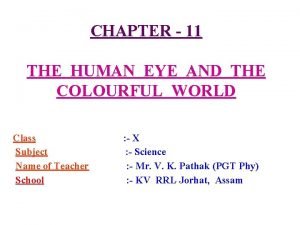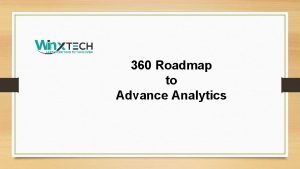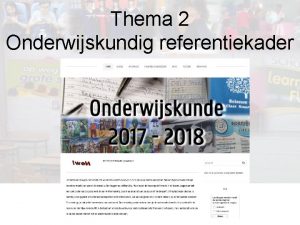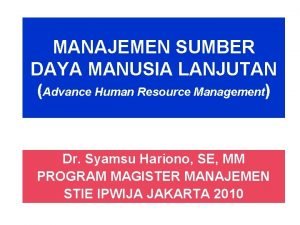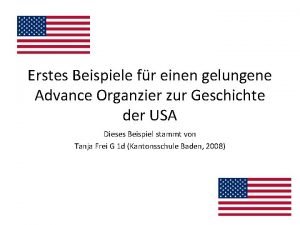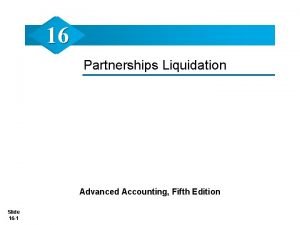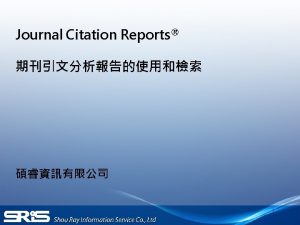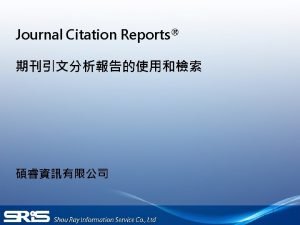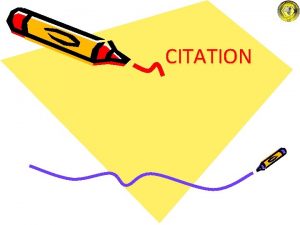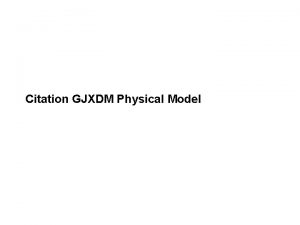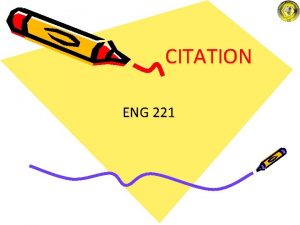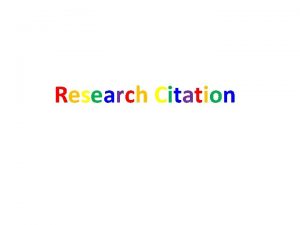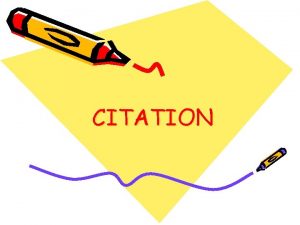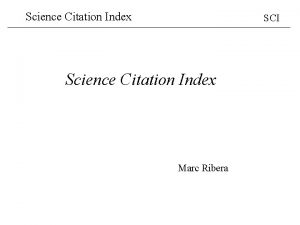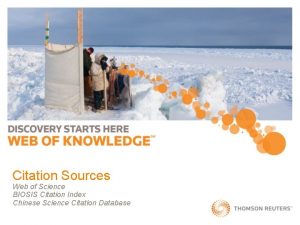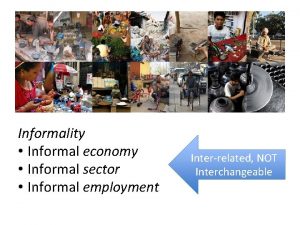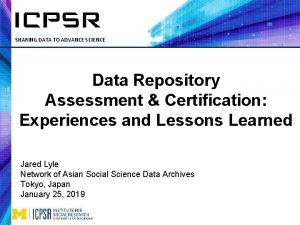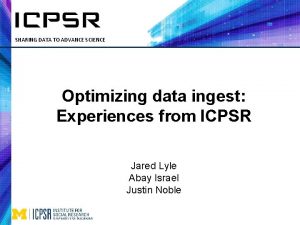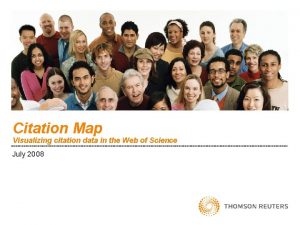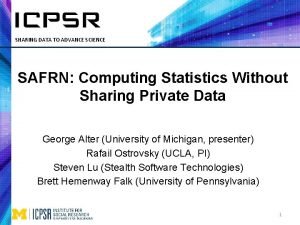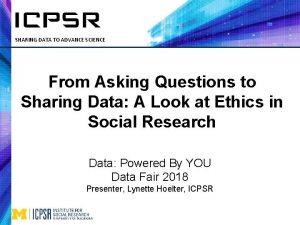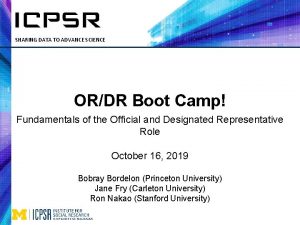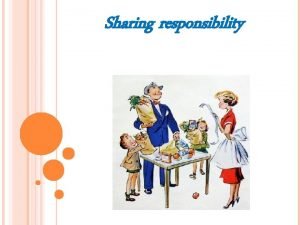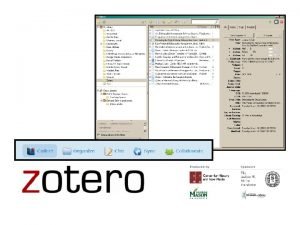SHARING DATA TO ADVANCE SCIENCE Informal Data Citation


















































- Slides: 50

SHARING DATA TO ADVANCE SCIENCE Informal Data Citation: Its Impact on Tracking Shared Data Reuse Elizabeth Moss & Jared Lyle IASSIST Sydney, NSW, Australia May 29, 2019

Overview • Why data citations matter • Challenges of tracking informal data citation • Specific types of informal data citation • Suggested improvements

http: //www. icpsr. umich. edu

ICPSR • Established 1962 • Originally 22 Members, now consortium of 776 world-wide • Originally Political Science, now all social and behavioral sciences Philip Converse, Warren Miller, and Angus Campbell Source: http: //www. icpsr. umich. edu/icpsrweb/content/membership/history/timeline. html

ICPSR • Current holdings • 10, 000+ studies, quarter million files • 1500+ are restricted studies, almost always to protect confidentiality • Approximately 60, 000 active My. Data (“shopping cart”) accounts • Thematic collections of data about addiction and HIV, aging, arts and culture, child care and early education, criminal justice, demography, health and medical care, and minorities

ICPSR Bibliography • 82, 000 citations of published and unpublished works resulting from analyses of data held in the ICPSR archive.

7


9

Benefits data depositors, users, and funders • Enables the discovery and re-use of data. . . via the datarelated literature, which can be less intimidating and more accessible than the raw data and documentation. • Helps users decide what data will fit their needs. . . by reading how others used the data, identifying cross-disciplinary implications and uses of the data, and avoiding duplicating analysis that has already been done. • Points to key research areas. . . allowing ICPSR to point to trending topics being addressed with data in the literature. • Encourages best practice. . . by attempting to make visible all published data use, both cited with a DOI and informally cited, to ensure credit is given and to promote transparency.

Dodd, S. A. (1979), Bibliographic references for numeric social science data files: Suggested guidelines. J. Am. Soc. Inf. Sci. , 30: 77– 82. doi: 10. 1002/asi. 4630300203 “Conclusion: Standardized procedures for bibliographic citations are designed to provide accurate and complete references, which in turn will be helpful to investigators and readers alike. It is hoped that guidelines or examples similar to the ones presented in this article will soon appear in the “authors’ guide” section of the social science journals and will eventually be included in such works as the Chicago A Manual of Style and Kate L. Turabian’s A Manual for Writers, etc. The ultimate goal would be to pave the way for social science data files to be included in printed bibliographies, end -of-work references, and indexing and abstracting works such as the Social Science Citation Index. ”

Researchers (n=247) were asked: “How interested would you be to know each of the following about the impact of your data? *White dots show the mean on a scale of one-to-four. J Kratz and C Strasser. 2015. Making data count. Nature Scientific Data 2: 150039. dx. doi. org/10. 1038/sdata. 2015. 39

• Downloads: Download counts, on the other hand, are both highly valuable and practical to collect. Downloads were a resounding second-choice metric for researchers and 85% of repositories already track them. • Citations: Citations are the coin of the academic realm. They were by far the most interesting metric to both researchers and data managers. Unfortunately, citations are much more difficult than download counts to work with, and relatively few repositories track them. Beyond technical complexity, the biggest challenge is cultural: data citation practices are inconsistent at best, and formal data citation is rare. Despite the difficulty, the value of citations is too high to ignore, even in the short term. https: //datapub. cdlib. org/2015/08/04/2334/

Challenges of tracking informal data citation


doi: 10. 3886/ICPSR 21240

In Science. Direct

But. . . tracking data use remains primarily a manual process • Most authors do not include formal data citations with machine-readable, persistent identifiers. • A 2018 study of biomedical literature by Park, You, and Wolfram found that “because only 62 of 513 observed instances of initial data reuse were included in the reference section of the examined articles, fewer than 20% of these citations are likely to be indexed in citation databases. ” • We risk not counting or linking 80% of data use if we do not track informal data citation.

How ICPSR finds and collects informally cited data-related publications 19

Challenge 1 (Humans): Authors don’t “cite data right” • We must create queries using the study name and other metadata. Limiting our collection to only those publications in which ICPSR DOIs were cited would mean most data use would go unlinked and uncounted. • Imprecise by nature, these queries can bring back what we consider to be bad hits. We do not collect data mentioned in passing. ICPSR only collects publications in which the data were analyzed, so distinguishing this must be done with human judgment. • Bad hits=time wasted. Each hit needs to be evaluated, in multiple locations, e. g. , the abstract, methods, acknowledgements, footnotes, references, etc.

6. Did author use something in a series, but didn’t say which specific study? Collect for series. 5. Was any year/wave/phase clearly analyzed but not cited in the references? Add those. 6. Collect citation and associate with study numbers from ICPSR catalog. 1. Is this already in the Bibliography? If no. . . 2. Were the data formally cited in the references? If no. . . 3. Where does query string appear in text? (tables, footnotes, methods, supplement, acknowledgements? ) Heuristic to evaluate publications for data use 4. If a good “hit” (data analyzed) – 5. If a bad “hit” (just mentioned or pub cited)— 5 a. If 5 a, find cited pubs & check for #1 --#5. If 5. Does ICPSR catalog have same years, waves, panel, sample?

Challenge 2 (Automation): No Adequate Tools Exist • Data repositories do not have the resources. Manual searching is burdensome for any large and growing collection. In ICPSR’s case, we grow by over a hundred new studies a year. • New automated linking tools are for PIDs only. Publishers and Cross. Ref/Data. Cite collaborate only on connecting PIDs together, not informally cited objects. • No good solution for automation at scale. Currently APIs can make comparisons, collection to collection, but that is not enough to be efficient, i. e. , high precision with high recall.

Challenge 2, cont’d: No Adequate Tools Exist • You can automate targeted searching at scale, but not evaluation at scale. ICPSR could use APIs to search at scale already. Potential matches based upon narrow identifier criteria (DOI, grant number, ICPSR study number), or a broad textual query (combinations of study title, investigator name, time period, geography, etc. ) would act as a filter to avoid, for instance, evaluating every article in Science. Direct against every ICPSR study. But this would just leave a lot more hits to be evaluated.

Specific types of informal data citation in current use

Almost complete Data are formally cited in the references, but the PID is not included, which would have enabled machineactionable detection and linking.

Indirect A title and year of the data are mentioned in the methods, so it is clear data were used and even named, but no formal reference is made to the data or where they may be accessed. Often, the reference provided is to another publication and not directly to the data.

Mismatched When the data are archived, the title may differ from the title used in publications prior to archiving. You see it in the literature this way: Title used when archived:

Barely there Authors may mention the name of a data collection, and may even provide the specific years analyzed. But they do not include the PID provided by the archive, let alone the version number. Not enough information is provided to know exactly where the author got the data.

Vaguely described by necessity The investigator writes about her own data well before having a citation and registered PID. Or, sometimes, in sensitive areas of research, authors tend to say as little as possible about identifying characteristics of the data, even in broad terms.

Deducible with inside information In some cases, even though no formal citation is used, an informed reader may know where the data were mandated to be deposited. In other cases, authors acknowledge assistance from a repository. Or, only a staff member with knowledge of some aspect of the data would be aware of an identifying characteristic.

https: //tuffpuppy. fandom. com/wiki/Mind_Reading_Helmet

Suggested improvements

Educate authors

https: //iassistdata. org/community/data-citation-ig/data-citation-resources

• Most authors do not include formal data citations with machine-readable, persistent identifiers. • A 2018 study of biomedical literature by Park, You, and Wolfram found that “because only 62 of 513 observed instances of initial data reuse were included in the reference section of the examined articles, fewer than 20% of these citations are likely to be indexed in citation databases. ” • We risk not counting or linking 80% of data use if we do not track informal data citation.

Rethink education about data citation Many authors don’t know they are supposed to cite data. Failing to give credit to data creators has not been considered plagiarism, nor is there any ethical standard that is uniformly handed down across the social sciences in codified pedagogy. Many authors still don’t know how to cite data. Until recently, there has been no universally accepted standard way to do so, little support for it in the major style guides, and often journals’ author instructions do not require that data be given attribution, let alone in the references.

Rethink education about data citation The author was taught to acknowledge data by citing a report or other written primary works, not the dataset, itself. “…authors (and journals) are confused by being asked to cite their own data in their references. You don’t cite your figures or tables, so why would you cite your data? Unless publishers and journals can re-educate the research community into always citing their own datasets, this approach seems unlikely to succeed. ” https: //scholarlykitchen. sspnet. org/2018/05/28/whats-up-with-datacitations/

Emphasize use of DOIs The author did cite the data in the references section, but either was prevented from using a DOI by the journal’s style guide, or did not realize there was one to use.

Change publisher practices

Publishers invest in citation tagging Devote extra resources at the typesetting phase to get the data citations right. • Publishers pushing for the inclusion of data citations in the references, and tagging them appropriately at typesetting stage. • In-text and data availability statements references to dataset DOIs being tagged as well, so that linkages between articles and their datasets are visible to Crossref, and authors can receive credit for the deposition of their data https: //scholarlykitchen. sspnet. org/2018/05/28/whats-up-with-data-citations/

Incentivize publishers to require data citations “Citations to a publisher’s journals boost Impact Factors, and hence eventual revenue, so having typesetters carefully curate article citations has a commercial incentive…. no such incentive exists for open data – having excellent connections between datasets and articles doesn’t have a clear path to future revenue. ” https: //scholarlykitchen. sspnet. org/2018/05/28/whats-up-with-data-citations/

https: //doi. org/10. 1096/fj. 12 -218164

https: //doi. org/10. 1096/fj. 12 -218164

Automation: Machine learning What we need is a tool that can evaluate (via scoring) whether a given article is likely citing (formally or informally) ICPSR study(s). An evaluative algorithm would be: • modular in nature (something we would install on our systems) • able to accept dataset metadata as one input, and the full text of the article as the other input, and return some sort of numeric score that reflects the accuracy of the match.

An evaluative algorithm would be, cont’d: • agnostic, i. e. , a repository’s developers could write crawlers that comb through other collections of articles (subscribed to by their institutions) and point those matches at the evaluative algorithm. • flexible, enabling a repository to set and modify thresholds for inclusion/exclusion (to control the volume of hits inherent in at-scale queries), e. g. : >90% automatically retain; 60 -90% flag for evaluation; <59% ignore entirely, though retain record so it doesn’t pop in future searches

Collaboration

Don’t worry…change takes time https: //pubsonline. informs. org/doi/pdf/10. 1287/inte. 1070. 0317

Suggestions?


Thank you! eammoss@umich. edu lyle@umich. edu
 Advance science
Advance science Economics … my favorite subject at school
Economics … my favorite subject at school Esci web of science
Esci web of science Social sciences citation index journal list
Social sciences citation index journal list Social science citation index
Social science citation index Norma inculta formal ejemplos
Norma inculta formal ejemplos Contoh model pengolahan data time sharing system
Contoh model pengolahan data time sharing system Sharing data
Sharing data Improved data sharing
Improved data sharing Informal science
Informal science Data citation index
Data citation index Proxy advance most
Proxy advance most Mandolin and clarinet
Mandolin and clarinet катетер export advance
катетер export advance What are the types of advance directives
What are the types of advance directives Cook in advance prefix
Cook in advance prefix Enduring understanding definition
Enduring understanding definition Nature advance online publication
Nature advance online publication Skimming advance organizer
Skimming advance organizer Lexis advance® reviews
Lexis advance® reviews Difference between loan and advance
Difference between loan and advance Planning is deciding in advance what is to be done
Planning is deciding in advance what is to be done Skimming advance graphic organizer
Skimming advance graphic organizer Cues and questions
Cues and questions Advance case management
Advance case management Thin cap rules
Thin cap rules What is advance organizer
What is advance organizer Personalwirtschaftliche aufgaben wahrnehmen
Personalwirtschaftliche aufgaben wahrnehmen Advantages and disadvantages of advance directives
Advantages and disadvantages of advance directives What are the types of advance directives
What are the types of advance directives Advance care directive tasmania
Advance care directive tasmania Abb advance switchgear
Abb advance switchgear Lesson 2 axis powers advance
Lesson 2 axis powers advance Thank you god in advance
Thank you god in advance Persiapan mahir dalam accurate
Persiapan mahir dalam accurate Direct mail inbound calls
Direct mail inbound calls Expository advance organizers examples
Expository advance organizers examples Trigene advance wipes
Trigene advance wipes Advance directives
Advance directives Faunet id lookup
Faunet id lookup Ddo templet
Ddo templet On entering a glass prism, sun‘s rays are
On entering a glass prism, sun‘s rays are Advance care planning verpleegkundige
Advance care planning verpleegkundige Advance analytics roadmap
Advance analytics roadmap Linkid katholiek onderwijs
Linkid katholiek onderwijs Advance human resources
Advance human resources Advance organizer unterricht
Advance organizer unterricht Advance organizer beispiele
Advance organizer beispiele Carlo renders
Carlo renders Click roll and advance
Click roll and advance Liquidation process in accounting
Liquidation process in accounting
